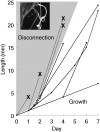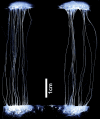Extreme stretch growth of integrated axons
- PMID: 15356212
- PMCID: PMC6729931
- DOI: 10.1523/JNEUROSCI.1974-04.2004
Extreme stretch growth of integrated axons
Abstract
Large animals can undergo enormous growth during development, suggesting that axons in nerves and white matter tracts rapidly expand as well. Because integrated axons have no growth cones to extend from, it has been postulated that mechanical forces may stimulate axon elongation matching the growth of the animal. However, this distinct form of rapid and sustained growth of integrated axons has never been demonstrated. Here, we used a microstepper motor system to evaluate the effects of escalating rates of stretch on integrated axon tracts over days to weeks in culture. We found that axon tracts could be stretch grown at rates of 8 mm/d and reach lengths of 10 cm without disconnection. Despite dynamic and long-term elongation, stretched axons increased in caliber by 35%, while the morphology and density of cytoskeletal constituents and organelles were maintained. These data provide the first evidence that mechanical stimuli can induce extreme "stretch growth" of integrated axon tracts, far exceeding any previously observed limits of axon growth.
Figures




Similar articles
-
Development of transplantable nervous tissue constructs comprised of stretch-grown axons.J Neurosci Methods. 2006 May 15;153(1):95-103. doi: 10.1016/j.jneumeth.2005.10.012. Epub 2005 Dec 5. J Neurosci Methods. 2006. PMID: 16337007
-
Development of a new miniaturized bioreactor for axon stretch growth.J Integr Neurosci. 2016 Sep;15(3):365-380. doi: 10.1142/S0219635216500230. Epub 2016 Oct 3. J Integr Neurosci. 2016. PMID: 27696926
-
A model for stretch growth of neurons.J Biomech. 2016 Dec 8;49(16):3934-3942. doi: 10.1016/j.jbiomech.2016.11.045. Epub 2016 Nov 18. J Biomech. 2016. PMID: 27890538 Free PMC article.
-
Stretch growth of integrated axon tracts: extremes and exploitations.Prog Neurobiol. 2009 Nov;89(3):231-9. doi: 10.1016/j.pneurobio.2009.07.006. Epub 2009 Aug 5. Prog Neurobiol. 2009. PMID: 19664679 Free PMC article. Review.
-
Integrating Chemistry and Mechanics: The Forces Driving Axon Growth.Annu Rev Cell Dev Biol. 2020 Oct 6;36:61-83. doi: 10.1146/annurev-cellbio-100818-125157. Epub 2020 Jun 30. Annu Rev Cell Dev Biol. 2020. PMID: 32603614 Review.
Cited by
-
Nerve crush but not displacement-induced stretch of the intra-arachnoidal facial nerve promotes facial palsy after cerebellopontine angle surgery.Exp Brain Res. 2016 Oct;234(10):2905-13. doi: 10.1007/s00221-016-4692-7. Epub 2016 Jun 8. Exp Brain Res. 2016. PMID: 27278084
-
The model of local axon homeostasis - explaining the role and regulation of microtubule bundles in axon maintenance and pathology.Neural Dev. 2019 Nov 9;14(1):11. doi: 10.1186/s13064-019-0134-0. Neural Dev. 2019. PMID: 31706327 Free PMC article. Review.
-
Applications of Human Brain Organoids to Clinical Problems.Dev Dyn. 2019 Jan;248(1):53-64. doi: 10.1002/dvdy.24662. Epub 2018 Oct 2. Dev Dyn. 2019. PMID: 30091290 Free PMC article. Review.
-
Perspectives on Mechanisms Supporting Neuronal Polarity From Small Animals to Humans.Front Cell Dev Biol. 2022 Apr 19;10:878142. doi: 10.3389/fcell.2022.878142. eCollection 2022. Front Cell Dev Biol. 2022. PMID: 35517494 Free PMC article. Review.
-
The Regulation of Axon Diameter: From Axonal Circumferential Contractility to Activity-Dependent Axon Swelling.Front Mol Neurosci. 2018 Sep 4;11:319. doi: 10.3389/fnmol.2018.00319. eCollection 2018. Front Mol Neurosci. 2018. PMID: 30233318 Free PMC article. Review.
References
-
- Alvarez J, Giuditta A, Koenig E (2000) Protein synthesis in axons and terminals: significance for maintenance, plasticity and regulation of phenotype. With a critique of slow transport theory. Prog Neurobiol 62: 1-62. - PubMed
-
- Bannister JL, Kemper CM, Warneke RM (1996) The action plan for Australian cetaceans. Canberra, Australia: Australian Nature Conservation Agency.
-
- Bray D (1979) Mechanical tension produced by nerve cells in tissue culture. J Cell Sci 37: 391-410. - PubMed
-
- Bray D (1984) Axonal growth in response to experimentally applied mechanical tension. Dev Biol 102: 379-389. - PubMed
-
- Bray D (1991) Isolated chick neurons for the study of axonal growth. In: Culturing nerve cells, Ed 1 (Banker G, Goslin K, eds), pp 119-135. Cambridge, MA: MIT.
Publication types
MeSH terms
Grants and funding
LinkOut - more resources
Full Text Sources
Other Literature Sources
